初中英语动词时态讲解
初中英语的时态知识点总结
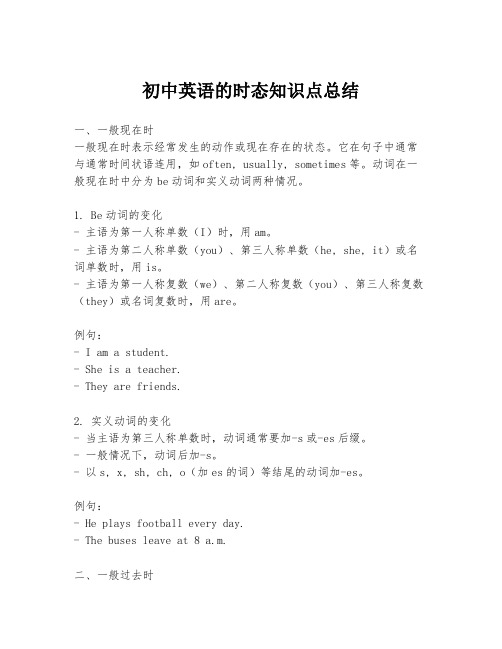
初中英语的时态知识点总结一、一般现在时一般现在时表示经常发生的动作或现在存在的状态。
它在句子中通常与通常时间状语连用,如often, usually, sometimes等。
动词在一般现在时中分为be动词和实义动词两种情况。
1. Be动词的变化- 主语为第一人称单数(I)时,用am。
- 主语为第二人称单数(you)、第三人称单数(he, she, it)或名词单数时,用is。
- 主语为第一人称复数(we)、第二人称复数(you)、第三人称复数(they)或名词复数时,用are。
例句:- I am a student.- She is a teacher.- They are friends.2. 实义动词的变化- 当主语为第三人称单数时,动词通常要加-s或-es后缀。
- 一般情况下,动词后加-s。
- 以s, x, sh, ch, o(加es的词)等结尾的动词加-es。
例句:- He plays football every day.- The buses leave at 8 a.m.二、一般过去时一般过去时表示过去某一确定时间发生的动作或存在的状态。
动词在一般过去时中要变为过去式,一般在词尾加-ed。
1. 规则变化- 动词词尾加-ed(如:played, visited)。
- 以e结尾的动词加-d(如:lived, danced)。
- 以辅音字母+y结尾的动词,变y为i再加-ed(如:studied, copied)。
2. 不规则变化不规则动词的过去式变化没有固定规则,需要特别记忆。
例如:- go去了went。
- eat吃了ate。
- begin开始began。
三、一般将来时一般将来时表示将来某一时间会发生的动作或状态。
它的构成主要有以下几种方式。
1. 将will或shall加在动词原形之前。
- I will go to school tomorrow.- He shall finish the work.2. 用“be going to + 动词原形”表示计划或打算做的事情。
初中英语知识归纳总结——动词的时态

初中英语知识归纳总结——动词的时态动词的时态(一)教学重点一般现在时在英语中,不同时间里以不同方式发生的动作或存在的状态,要用不同的动词形式来表示,动词的这种不同形式称为动词的时态。
时态从时间上划分,可分为四大类:现在时;过去时;将来时;过去将来时。
从行为上,每一类可以分为四种形式:一般式;进行式;完成式;完成进行式。
这样英语的动词合起来,总共有十六种时态,初中只需掌握其中的八种时态。
1、一般现在时(1)一般现在时表示现在的状态、习惯性的动作或主语所具备的性格和能力等。
①当动词是be时,第一人称用am,第二人称用is,其他人称用are.②当动词是实义动词时,一般用动词原形,但如果主语是第三人称单数时,动词必须用第三人称单数形式,其变化规则如下:助动词do(第三人称单数用does)构成否定句、疑问句及答语,但要注意助动词后原来的谓语动词要恢复原形。
例如:I like music.I don’t like music.Do you like music?Yes, I do No, I don’t(2)一般现在时的用法①表示经常、习惯性动作,常和often, usually, every day, sometimes, always 等时间状语连用。
如:He goes to school by bus every day.They often play football②表示能力、职业、特征。
如:Miss Gao teaches English.Do you speak Japanese?③表示客观存在。
如:The earth moves round the sun.Time and tide wait for no man.④表示已经安排好或计划好的事。
如The plane takes off at 7:30.Classes begin at 8:00⑤在时间状语和条件状语从句中,主句用一般将来时,从句用一般现在时。
初中英语中考复习时态讲解课件(共79张ppt)

一般现在时
1. 表示经常性或习惯性的动作
She does excersice everyday.
真题链接
—What do you often do at weekends?
—I often ____ my grandparents.
A. visit
B. visited
C. have visited D. will visit
Just a moment, I am washing dishes.
when
习题
Just a minute! My brother________ his car in the garden. A. washes B. is washing C. washed D. will wash
习题
---Hey, Tom. Let’s go swimming.
动词过去分词 不规则变化
speak hear see give build swim buy teach
spoken heard seen given built swum bought taught
现在完成时
already yet
1.过去发生或已完成的某一动作对现在的影响。
I have already watched this film. I haven't watched this film yet. I have already visited America. I haven't visited America yet.
A. prepares
B. is preparing
C. has prepared D. prepared
真题链接
--Mum, it's late. Why are you still here? --Dad hasn't come back yet. I ____ for him. A. am waitingB. was waiting C. waited D. had waited
初中英语知识点归纳动词的不同时态与语态

初中英语知识点归纳动词的不同时态与语态动词的不同时态与语态是初中英语的重要知识点。
掌握了动词的时态和语态,我们就能更准确地表达过去、现在和将来的动作,以及主语对动作的不同态度。
下面是对初中英语中动词的不同时态与语态的归纳总结。
一、动词的时态1. 一般现在时一般现在时表示经常性或习惯性的动作、客观真理、固定事件等。
例句:- I go to school every day.(我每天去上学。
)- The sun rises in the east.(太阳从东方升起。
)2. 现在进行时现在进行时表示现在正在进行的动作。
例句:- He is watching TV now.(他正在看电视。
)- They are playing basketball in the park.(他们正在公园里打篮球。
)3. 一般过去时一般过去时表示过去发生的动作或存在的状态。
例句:- We watched a movie last night.(昨晚我们看了一场电影。
)- She lived in Beijing when she was young.(她年轻时住在北京。
)4. 过去进行时过去进行时表示过去某个时间正在进行的动作。
例句:- They were having dinner at 7 o'clock yesterday.(昨天7点他们正在吃晚饭。
)- At this time last year, I was studying in London.(去年这个时间,我正在伦敦学习。
)5. 将来时将来时表示将要发生的动作或存在的状态。
例句:- We will go to the beach next week.(下周我们将去海滩。
)- She is going to visit her grandparents tomorrow.(她明天将要去看望她的祖父母。
)二、动词的语态1. 主动语态主动语态表示主语是动作的执行者。
动词时态的用法说明(初中英语)

动词时态一、概念:英语中不同时间和方式发生的动作或状态要用谓语动词的不同形式来表示,这种表示动作或状态发生时间和方式的动词形式称作动词时态。
二、动词时态的种类:动词时态共16种,但初中阶段要求掌握的有八种:一般现在时一般过去时现在进行时过去进行时一般将来时过去将来时现在完成时过去完成时三、动词时态的构成:1.一般现在时(do、does);2.一般过去时(did);3.一般将来时( will do)(be going to do);4.过去将来时( would do)/(was/were going to do);5.现在进行时( am/is/are doing);6.过去进行时(was/were doing);7. 现在完成时(have done);8.过去完成时( had done);四、动词时态用法解读:1. 一般现在时1) 经常性或习惯性的动作,常与表示频率的时间状语连用。
时间状语:every…,sometimes,often, always, in the morning. at…,on SundayI leave home for school at 7 every morning.,twice a week2) 客观事实,普遍真理。
The earth moves around the sun.Shanghai lies in the east of China.3) 表示格言或警句中。
Pride goes before a fall.骄者必败。
注意:此用法如果出现在宾语从句中,即使主句是过去时,从句谓语也要用一般现在时。
例:Columbus(哥伦布)proved that the earth is round..4) 现在时刻的状态、能力、性格、个性。
I don't want so much.Ann Wang writes good English but does not speak well.比较:Now I put the sugar in the cup.I am doing my homework now.5﹞主将从现﹝主句用将来时从句用现在时﹞①I will tell you,When Li Ming comes②I'll e-mail you as soon as I get to Beijing.注一般从句为时间状语从句「由When As soon as...引导的从句」条件状语从句「由If...引导的从句」6)表示按计划,规定要发生的动作,但仅限于少数动词如:begin,come,leave,go等The meeting begins at seven.2. 一般过去时1)在确定的过去时间里所发生的动作或存在的状态。
初中动词的时态与语态
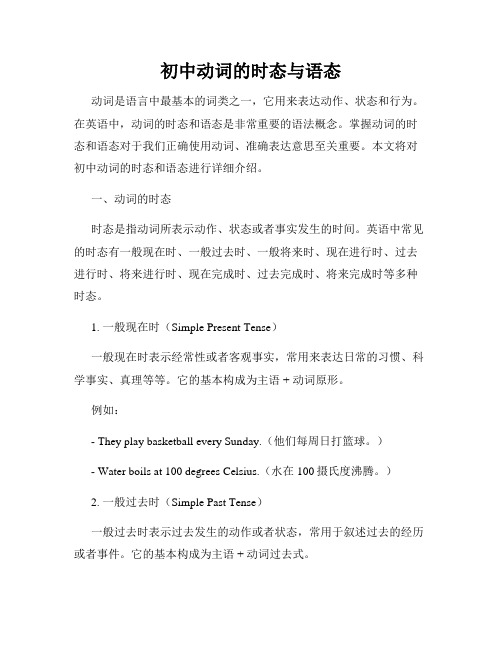
初中动词的时态与语态动词是语言中最基本的词类之一,它用来表达动作、状态和行为。
在英语中,动词的时态和语态是非常重要的语法概念。
掌握动词的时态和语态对于我们正确使用动词、准确表达意思至关重要。
本文将对初中动词的时态和语态进行详细介绍。
一、动词的时态时态是指动词所表示动作、状态或者事实发生的时间。
英语中常见的时态有一般现在时、一般过去时、一般将来时、现在进行时、过去进行时、将来进行时、现在完成时、过去完成时、将来完成时等多种时态。
1. 一般现在时(Simple Present Tense)一般现在时表示经常性或者客观事实,常用来表达日常的习惯、科学事实、真理等等。
它的基本构成为主语 + 动词原形。
例如:- They play basketball every Sunday.(他们每周日打篮球。
)- Water boils at 100 degrees Celsius.(水在100摄氏度沸腾。
)2. 一般过去时(Simple Past Tense)一般过去时表示过去发生的动作或者状态,常用于叙述过去的经历或者事件。
它的基本构成为主语 + 动词过去式。
例如:- I visited my grandparents last weekend.(我上个周末去看望了我的祖父母。
)- She didn't go to school yesterday.(她昨天没有去上学。
)3. 一般将来时(Simple Future Tense)一般将来时表示将来要发生的动作或者状态,常用于表达计划、打算、预测等等。
它的基本构成为主语 + will + 动词原形。
例如:- We will have a party next Friday.(我们下周五要举办一个聚会。
)- She won't come to the meeting tomorrow.(她明天不会来参加会议。
)4. 现在进行时(Present Continuous Tense)现在进行时表示正在进行的动作,通常用于描述当前正在发生的事情。
初中英语语法—时态(28张) PPT课件 图文

(4)现在完成时与表示一段时间的for短语、since短语或从句等 时,应注意句中的谓语动词须是延续性的,而不能是非延续性动词,如 come→be here,go→be there,die→be dead,borrow→keep,buy→h ,join→be in,leave→be away,begin to study→study等。
6.过去进行时
(1)概念:表示过去某一时刻或某一时间段内正在进行的动作。 (2)构成形式:was/were+动词的-ing形式 ①表示往返、位移的动词的过去进行时常可用来表示过去将来时
时态 We wanted to tell her that the train was_leaving an hour later.
1.一般现在时
基本用法: (1)表示经常性、习惯性的动作; He always helps others. 他总是帮助别人。
时态 (2)表示现在的情况或状态;
He is a teacher. 他是个老师。 (3)表示客观事实和普遍真理。 The sun rises in the east. 太阳从东边升起。 构成形式:am/is/are或实义动词的原形(主语是第三人称单数时,动 词要用第三人称单数形式)。
时态 (2)构成形式:have/has+动词的过去分词。
(3)与现在完成时连用的时间状语有for a long time,recently,yet, lately,ever,never,already,since,by this time,before,just,in t past/last few years,since+过去的时间点,since+时间段+ago,since +从句(一般过去时)。
表示感觉的动词。如:see,hear等。 表示喜欢或厌恶的动词。如:like,love等。 表示希望的动词。如:want,would like等。
初中英语动词八大时态讲解PPT课件

疑问找助动词:do, does
否定找助动词:don’t ,doesn’t
.Hale Waihona Puke 3二、一般过去时 1、be 式动词:
was were 一般过去时 2、实义动词: 使用动词的过去式 (分为规则与不规则) 疑问否定:. did, did’t 4
三 、现在进行时
Is / am /are + doing (注意现在分词的构成)
六、过去完成时:过去的过去
在过去某时间(或动作)看来已经
完成了的动作 :had + done
常见的句型:
①过去完成时 + by the time …
②过去完成时 + by the end of+ 过去的时间
③过去完成时+ when + 一般过去时的句子
④过去完成时+ before + 一般过去时的句子
1、直接+ing
2、去掉e,+
ing
现在进行 时
3、双写+ing
.
5
四、过去进行时 过去进行时
was / were + doing
注意过去进行时与一般过去时的
区别:
1、意义上:过去进行时指过去某
点或某段时间正在进行的动作;而
一般过去时指在过去的时间里所
发生事实。
2、动词使用的形式. 不同
6
五、现在完成时 1、have/ has + done (动作发生在过去对现在造成的 结果或影响) 2、常见的时间状语或句型 ①already,just,ever,never,yet
考点:主句为一般将来时,从句(条件)
用一般现在时。
•We will not go out if it snows tomorrow.
初中英语八大时态详解,满满的干货!
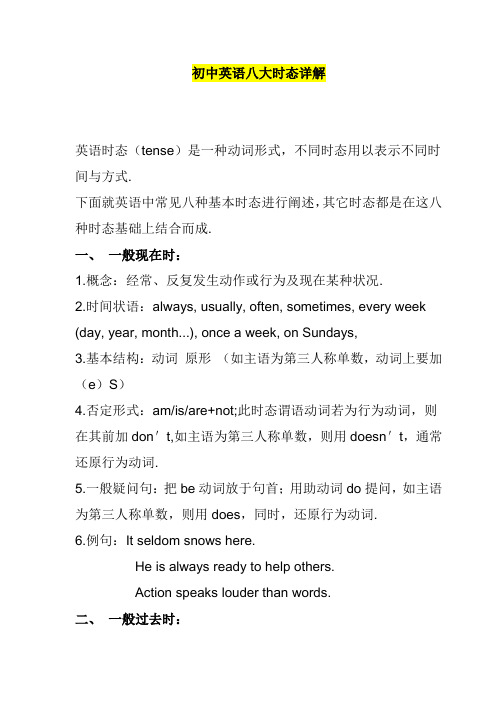
初中英语八大时态详解英语时态(tense)是一种动词形式,不同时态用以表示不同时间与方式.下面就英语中常见八种基本时态进行阐述,其它时态都是在这八种时态基础上结合而成.一、一般现在时:1.概念:经常、反复发生动作或行为及现在某种状况.2.时间状语:always, usually, often, sometimes, every week (day, year, month...), once a week, on Sundays,3.基本结构:动词原形(如主语为第三人称单数,动词上要加(e)S)4.否定形式:am/is/are+not;此时态谓语动词若为行为动词,则在其前加don't,如主语为第三人称单数,则用doesn't,通常还原行为动词.5.一般疑问句:把be动词放于句首;用助动词do提问,如主语为第三人称单数,则用does,同时,还原行为动词.6.例句:It seldom snows here.He is always ready to help others.Action speaks louder than words.二、一般过去时:1.概念:过去某个时间里发生动作或状态;过去习惯性、经常性动作、行为.2.时间状语:ago, yesterday, the day before yesterday, last week(year, night, month…), in 1989, just now, at the age of 5, one day, long long ago, once upon a time, etc.3.基本结构:be动词;行为动词4.否定形式:was/were+not;在行为动词前加didn't,同时还原行为动词.5.一般疑问句:was或were放于句首;用助动词do过去式did 提问,同时还原行为动词.6.例句:She often came to help us in those days.I didn't know you were so busy.三、现在进行时:1.概念:表示现阶段或说话时正在进行动作及行为.2.时间状语:now, at this time, these days, etc.3.基本结构:am/is/are+doing4.否定形式:am/is/are+not+doing.5.一般疑问句:把be动词放于句首.6.例句:How are you feeling today?He is doing well in his lessons.四、过去进行时:1.概念:表示过去某段时间或某一时刻正在发生或进行行为或动作.2.时间状语:at this time yesterday, at that time或以when引导谓语动词是一般过去时时间状语等.3.基本结构:was/were+doing4.否定形式:was/were + not + doing.5.一般疑问句:把was或were放于句首.6.例句:At that time she was working in a PLA unit.When he came in, I was reading a newspaper.五、现在完成时:1.概念:过去发生或已经完成动作对现在造成影响或结果,或从过去已经开始,持续到现在动作或状态.2.时间状语:recently, lately, since…for…,in th e past few years, etc.3.基本结构:have/has + done4.否定形式:have/has + not +done.5.一般疑问句:have或has提前6.例句:I've written an article.It has been raining these days.六、过去完成时:1.概念:以过去某个时间为标准,在此以前发生动作或行为,或在过去某动作之前完成行为,即“过去过去”.2.时间状语:before, by the end of last year(term, month…),etc.3.基本结构:had + done.4.否定形式:had + not + done.5.一般疑问句:had放于句首.6.例句:As soon as we got to the station, the train had left.By the end of last month. We had reviewed four books七、一般将来时:1.概念:表示将要发生动作或存在状态及打算、计划或准备做某事.2.时间状语:tomorrow, next day(week, month, year…),soon, ina few minutes, by…,the day after tomorrow, etc.3.基本结构:am/is/are/going to + do;will/shall + do.4.否定形式:was/were + not; 在行为动词前加won't,同时还原行为动词.5.一般疑问句:be放于句首;will/shall提到句首.6.例句:They are going to have a competition with us in studies.It is going to rain.八、过去将来时:1.概念:立足于过去某一时刻,从过去看将来,常用于宾语从句中.2.时间状语:the next day(morning, year…),the following month(week…),etc.3.基本结构:was/were/going to do;would/should + do.4.否定形式:was/were/not + going to + do;would/should + not + do.5.一般疑问句:was或were放于句首;would/should 提到句首.6.例句:He said he would go to Beijing the next day.I asked who was going there .小结:1.一般现在时: 主语+do/does(现在分词)e.g We clean the room every day.2.一般过去时: 主语+dide.g We cleaned the room just now.3.现在进行时: 主语+am/is/are doinge.g We are cleaning the room now.4.过去进行时: was/were doinge.g We were cheaning the room at 5:00 yesterday afternoon.5.现在完成时: have/has donee.g.We have cleaned the room already.6.过去完成时: had donee.g We had cleaned the room before he arrived.7.一般将来时: will do/e.g We will clean the room tomorrow.8.过去将来时: was/were to /would doe.g He said he would clean the room next.。
初中英语语法八大时态总结(完整版)
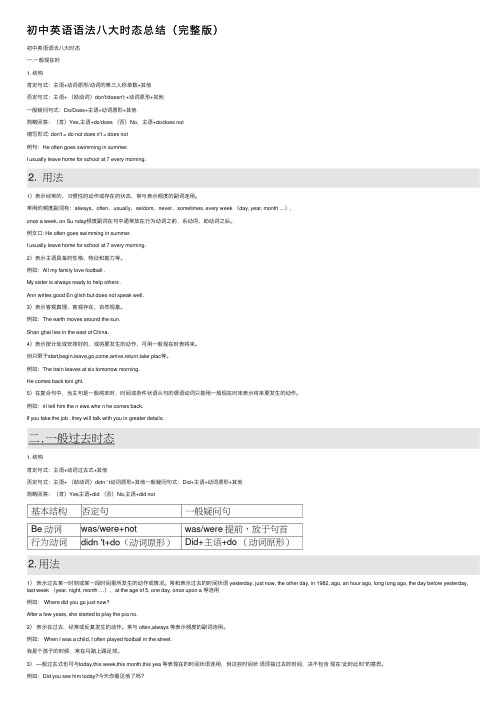
初中英语语法⼋⼤时态总结(完整版)初中英语语法⼋⼤时态⼀.⼀般现在时1. 结构肯定句式:主语+动词原形/动词的第三⼈称单数+其他否定句式:主语+ (助动词)don't/doesn't +动词原形+其他⼀般疑问句式:Do/Does+主语+动词原形+其他简略回答:(肯)Yes,主语+do/does (否)No,主语+do/does not缩写形式: don't = do not does n't = does not例句:He often goes swimming in summer.I usually leave home for school at 7 every morning.1)表⽰经常的、习惯性的动作或存在的状态,常与表⽰频度的副词连⽤。
常⽤的频度副词有:always、often、usually、seldom、never、sometimes, every week (day, year, month …),once a week, on Su nday频度副词在句中通常放在⾏为动词之前,系动词、助动词之后。
例⼥⼝: He often goes swimming in summer.I usually leave home for school at 7 every morning.2)表⽰主语具备的性格、特征和能⼒等。
例如:All my family love football .My sister is always ready to help others .Ann writes good En glish but does not speak well.3)表⽰客观真理、客观存在、⾃然现象。
例如:The earth moves around the sun.Shan ghai lies in the east of China.4)表⽰按计划或安排好的,或将要发⽣的动作,可⽤⼀般现在时表将来。
(完整版)初中英语动词时态和语态讲解

初中英语动词时态和语态讲解动词的时态和语态(一)动词是谓语动所表示的动作或情况发生时间的各种形式。
英语动词有16种时态,但是常用的只有9种:一般现在时、一般过去时、一般将来时、现在进行时、过去进行时、现在完成时、过去完成时、过去将来时、现在完成进行时。
下面分别介绍。
1、一般现在时的用法1)表示经常性、习惯性的动作;表示现在的状态、特征和真理.句中常用 often, usually, every day 等时间状语。
例如:a. He goes to school every day。
b. He is very happy。
c。
The earth moves around the sun。
2)在时间状语从句和条件状语从句中,用一般现在时表示将来。
例如:a。
If you come this afternoon,we’ll have a meeting.b. When I graduate, I'll go to countryside.3) 有时这个时态表示按计划、规定要发生的动作(句中都带有时间状语),但限于少数动词,如:begin, come, leave, go ,arrive, start , stop, return, open, close等。
例如:a. The meeting begins at seven。
b. The rain starts at nine in the morning。
4) 表示状态和感觉的动词(be, like, hate, think, remember, find, sound 等)常用一般现在进行时。
a. I like English very much。
b。
The story sound very interesting.5) 书报的标题、小说等情节介绍常用一般现在时。
2.一般现在时的用法1)表示过去某时间发生的事、存在的状态或过反复发生的动作。
初中英语必考八大时态结构及用法详解
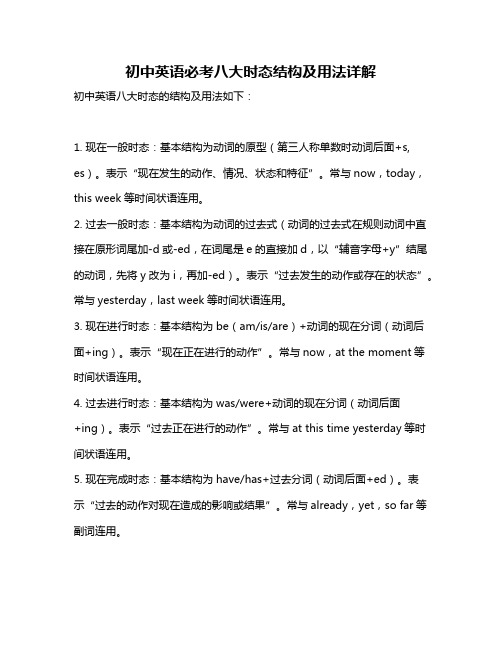
初中英语必考八大时态结构及用法详解初中英语八大时态的结构及用法如下:1. 现在一般时态:基本结构为动词的原型(第三人称单数时动词后面+s, es)。
表示“现在发生的动作、情况、状态和特征”。
常与now,today,this week等时间状语连用。
2. 过去一般时态:基本结构为动词的过去式(动词的过去式在规则动词中直接在原形词尾加-d或-ed,在词尾是e的直接加d,以“辅音字母+y”结尾的动词,先将y改为i,再加-ed)。
表示“过去发生的动作或存在的状态”。
常与yesterday,last week等时间状语连用。
3. 现在进行时态:基本结构为be(am/is/are)+动词的现在分词(动词后面+ing)。
表示“现在正在进行的动作”。
常与now,at the moment等时间状语连用。
4. 过去进行时态:基本结构为was/were+动词的现在分词(动词后面+ing)。
表示“过去正在进行的动作”。
常与at this time yesterday等时间状语连用。
5. 现在完成时态:基本结构为have/has+过去分词(动词后面+ed)。
表示“过去的动作对现在造成的影响或结果”。
常与already,yet,so far等副词连用。
6. 过去完成时态:基本结构为had+过去分词(动词后面+ed)。
表示“过去的动作在过去的某个时间之前已经完成或发生的动作或存在的状态”。
常与by the end of last year,by the time of等时间状语连用。
7. 现在完成进行时态:基本结构为have/has been+动词的现在分词(动词后面+ing)。
表示“动作从过去某时开始,一直延续到现在,或者刚刚完成”。
常与for several days,since等时间状语连用。
8. 过去完成进行时态:基本结构为had been+动词的现在分词(动词后面+ing)。
表示“过去的某个动作从过去某时开始,一直延续到过去的某个时间,或者刚刚完成”。
初中英语时态讲解
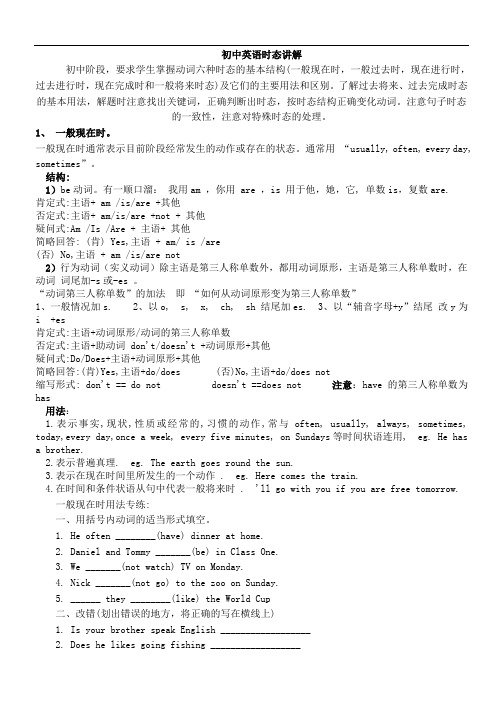
初中英语时态讲解初中阶段,要求学生掌握动词六种时态的基本结构(一般现在时,一般过去时,现在进行时,过去进行时,现在完成时和一般将来时态)及它们的主要用法和区别。
了解过去将来、过去完成时态的基本用法,解题时注意找出关键词,正确判断出时态,按时态结构正确变化动词。
注意句子时态的一致性,注意对特殊时态的处理。
1、一般现在时。
一般现在时通常表示目前阶段经常发生的动作或存在的状态。
通常用“usually, often, every day, sometimes”。
结构:1)be动词。
有一顺口溜:我用am ,你用 are ,is 用于他,她,它, 单数is,复数are.肯定式:主语+ am /is/are +其他否定式:主语+ am/is/are +not + 其他疑问式:Am /Is /Are + 主语+ 其他简略回答: (肯) Yes,主语 + am/ is /are(否) No,主语 + am /is/are not2)行为动词(实义动词)除主语是第三人称单数外,都用动词原形,主语是第三人称单数时,在动词词尾加-s或-es 。
“动词第三人称单数”的加法即“如何从动词原形变为第三人称单数”1、一般情况加s.2、以o, s, x, ch, sh 结尾加es.3、以“辅音字母+y”结尾改y为i +es肯定式:主语+动词原形/动词的第三人称单数否定式:主语+助动词 don't/doesn't +动词原形+其他疑问式:Do/Does+主语+动词原形+其他简略回答:(肯)Yes,主语+do/does (否)No,主语+do/does not缩写形式: don't == do not doesn't ==does not 注意:have的第三人称单数为has用法:1.表示事实,现状,性质或经常的,习惯的动作,常与often, usually, always, sometimes, today,every day,once a week, every five minutes, on Sundays等时间状语连用, eg. He hasa brother.2.表示普遍真理. eg. The earth goes round the sun.3.表示在现在时间里所发生的一个动作 . eg. Here comes the train.4.在时间和条件状语从句中代表一般将来时 . 'll go with you if you are free tomorrow.一般现在时用法专练:一、用括号内动词的适当形式填空。
初中英语语法动词八种时态详解

初中英语语法动词八种时态详解初中英语语法动词八种时态详解:现在完成时对于初接触现在完成时的人来说,往往会产生一种茫然,因为它似乎与一般过去时相似。
那就是,这两种时态描述的动作都始于过去。
其实不然,现在完成时主要表示,发生在过去的动作延续到现在刚刚完成、或许还要延续;侧重于这个动作对现在带来的结果、产生的影响、积累的总和等等。
而一般过去时则只不过是表示动作发生在过去的什么时候。
弄清了这一区别,就很容易理解现在完成时了。
1)表示截止现在业已完成的动作By now, I have collected all the data that I need .到现在为止,我已收集到了我所需的全部资料。
She has read 150 pages today .她今天已看了150页。
We haven't met for many years .我们已多年没见了。
They have developed a new product .他们研制成功了一种新产品。
2)表示发生在过去而对现在产生影响、带来结果的动作Have you had your dinner? 你吃晚饭了吗?She has been to the United States. 她已去美国了。
You have grown much taller.你长高了许多。
3)表示过去发生的动作持续到现在,并可能还要延续It has been five years since he joined the army .他参军五年了。
They have learned English for eight years .他们已学了八年的英语了。
So far we've only discussed the first five chapters.至今我们还只讨论了前五章。
几点注意1)一个句子应该用什么时态只能取决于它需要表达的意思,以及它所处的语言环境。
例如:He speaks English .(一般现在时,说明动作发生的经常性。
初中英语动词八大时态详解
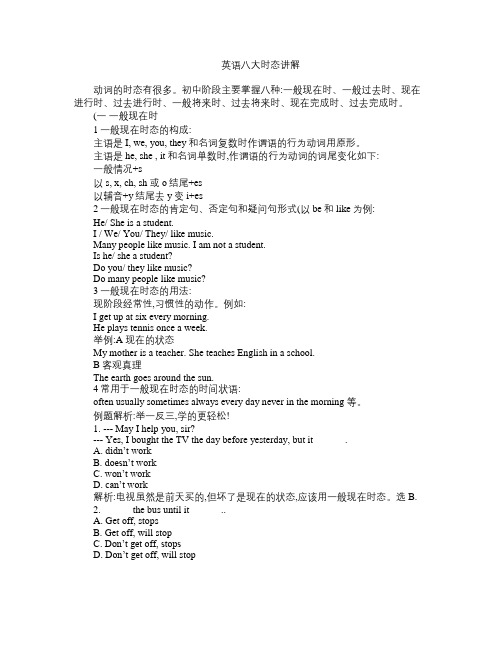
英语八大时态讲解动词的时态有很多。
初中阶段主要掌握八种:一般现在时、一般过去时、现在进行时、过去进行时、一般将来时、过去将来时、现在完成时、过去完成时。
(一一般现在时1一般现在时态的构成:主语是I, we, you, they和名词复数时作谓语的行为动词用原形。
主语是he, she , it和名词单数时,作谓语的行为动词的词尾变化如下:一般情况+s以s, x, ch, sh 或o结尾+es以辅音+y结尾去y变i+es2一般现在时态的肯定句、否定句和疑问句形式(以be和like为例:He/ She is a student.I / We/ You/ They/ like music.Many people like music. I am not a student.Is he/ she a student?Do you/ they like music?Do many people like music?3一般现在时态的用法:现阶段经常性,习惯性的动作。
例如:I get up at six every morning.He plays tennis once a week.举例:A 现在的状态My mother is a teacher. She teaches English in a school.B 客观真理The earth goes around the sun.4常用于一般现在时态的时间状语:often usually sometimes always every day never in the morning 等。
例题解析:举一反三,学的更轻松!1. --- May I help you, sir?--- Yes, I bought the TV the day before yesterday, but it ______.A. didn’t workB. doesn’t workC. won’t workD. can’t work解析:电视虽然是前天买的,但坏了是现在的状态,应该用一般现在时态。
初中英语八大时态讲解_图文

2 have been to+地点,表示“去过某地”
。(人已回) I have been to Europe. (I am not in Europe now.)
3 have been in+地点+时间段,表示“在/ 来某地多久”。
I have been in Europe for three weeks. (I am now still in Europe .)
go there get home open close get to know borrow buy
be there be home be open be closed know keep have
1.The film began 5 The film_h_a_s b_e_en_o_n__ for 5
• 9.They got to know 10 They_h_av_e_k_n_o_w_n__since 10
years ago.
years ago.
• 10.I borrowed the book a I_h_a_v_e _k_e_p_t _the book for a
week ago.
week.
二、一般过去时
1.用法:过去的动作或状态。
2.标志词:
yesterday, the day before yesterday,
three days ago, last night/week/month…,in the past;just
now=a moment ago
例题
Li Ming didn’t understand what American people
4.He joined the club 3 He__h_as_b_e_en_i_n__the club for
初中英语时态讲解(完整版)
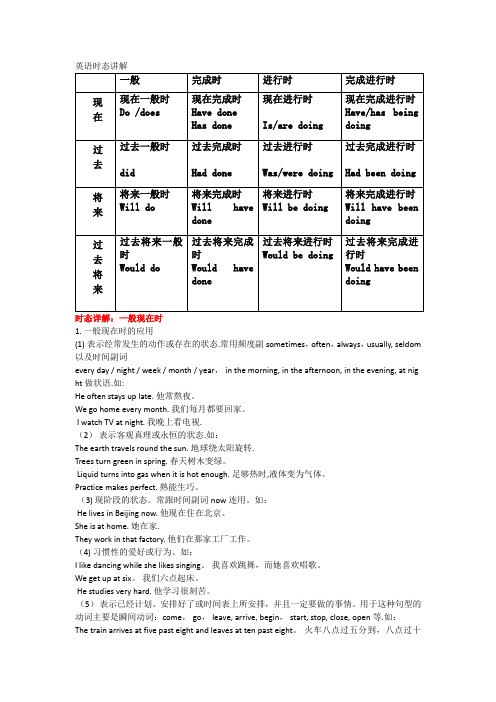
英语时态讲解1.一般现在时的应用(1)表示经常发生的动作或存在的状态.常用频度副sometimes,often,always,usually,seldom 以及时间副词every day/night/week/month/year,in the morning,in the afternoon,in the evening,at nig ht做状语.如:He often stays up late.他常熬夜。
We go home every month.我们每月都要回家。
I watch TV at night.我晚上看电视.(2)表示客观真理或永恒的状态.如:The earth travels round the sun.地球绕太阳旋转.Trees turn green in spring.春天树木变绿。
Liquid turns into gas when it is hot enough.足够热时,液体变为气体。
Practice makes perfect.熟能生巧。
(3)现阶段的状态。
常跟时间副词now连用。
如:He lives in Beijing now.他现在住在北京。
She is at home.她在家.They work in that factory.他们在那家工厂工作。
(4)习惯性的爱好或行为。
如:I like dancing while she likes singing。
我喜欢跳舞,而她喜欢唱歌。
We get up at six。
我们六点起床。
He studies very hard.他学习很刻苦。
(5)表示已经计划、安排好了或时间表上所安排,并且一定要做的事情。
用于这种句型的动词主要是瞬间动词:come,go,leave,arrive,begin,start,stop,close,open等.如:The train arrives at five past eight and leaves at ten past eight。
初中英语语法动词八种时态详解

初中英语八种时态归纳复习 时态是英语学习中一个至关重要的内容,广大初中学生在实际运用时,往往对时态问题倍感棘手,下面我们就归纳复习一下这几种时态。
1、一般现在时(一)定义表示经常性或习惯性的动作,或存在的状态,还表示主语具备的性格和能力及客观真理。
例:I get up at 6:30 in the morning .She is at home.(二)构成主要用动词原形表示,当主语是第三人称单数时,在动词词尾加s/es。
(三)句型1、肯定句:主语+谓语+其他。
She reads English everyday.2、否定句:主语+don’t/doesn’t+谓语+其他。
He doesn’t get up at 6:30 in the morning.3、一般疑问句:Do/Does+主语+V原+其他?Do you like English? Yes, I do. /No, I don’t.4、特殊疑问句:特殊疑问词+do/does+主语+V原+其他?What time do you get up every morning?Where does your father work?(三)用法1、表示经常性或习惯性的动作,或存在的状态,带与表示频率的时间状语如:often , sometimes , usually,always , everyday year,month...) , once/twice a week (month, year, etc.) seldom, on Sunday等连用。
I leave home for school at seven every morning.2、表示客观真理,科学事实、格言警句。
The sun rises in the east .日出东方。
The earth goes around the sun .地球绕着太阳转。
Ten minus two is eight.十减二等于八。
初中英语8个时态讲解—中考必考-

初中英语8个时态讲解—中考必考英英英英英英英一般现在时一一一一一一一1、一一一一一一一一一一一。
She often speaks English.I leave home for school at 7 every morning.2、一一一一一一一一一一一一一一一一一一一一。
He seems to feel a bit down today.He works as a driver.3、一一一一一一一一一一一一一一一一一一一一一一。
Shanghai lies in the east of China.Columbus proved that the earth is round.Where there is a will, there is a way.一一一一一一一一一一一一一一一一一一一一一一一一一。
When Bill comes , ask him to wait for me.I shall go there tomorrow unless I’m too busy.一般过去时一一一一一一一一1、一一一一一一一一一一一一一一一一一一。
Jim rang you just now.Liu Ying was in America last year.2、一一一一一一一一一一一一一一,一一一used to do sth.一一一一一一一一一一一一一一一一一一When I was a kid, I often played football in the street.She used to visit her mother once a week.*一一一一:sb. used to do sth.一一一一一一一一一一一一一to一一一一一一一一一一一一sb. be used to sth./doing sth.一一一一一一一一/一一一一一一to一一一一一3、一一一一一一一一一一一一一一一一一一一一一一一一一一一一一一一一一一一一一一一一want, hope, wonder, think, intend一一一一一一一could, would一I wondered if you could have a word with me.I hoped you could help me with my English.Would you mind my sitting here?一般将来时一一一will / shall +一一一一1、一一一一一一一一一一一一一一一。
- 1、下载文档前请自行甄别文档内容的完整性,平台不提供额外的编辑、内容补充、找答案等附加服务。
- 2、"仅部分预览"的文档,不可在线预览部分如存在完整性等问题,可反馈申请退款(可完整预览的文档不适用该条件!)。
- 3、如文档侵犯您的权益,请联系客服反馈,我们会尽快为您处理(人工客服工作时间:9:00-18:30)。
初中英语语法:动词时态专讲一、概说动词的时态历来是中考题中考查的重头戏之一。
测试重点放在根据特定语言环境区别使用一般现在时,一般过去时和现在完成时;一般现在时(过去时)与现在(过去)进行时;特定的时间状语中时态的使用;结合所获得的语言知识确定正确时态的能力等。
综上所述,动词的时态在中考测试中的地位非常重要。
因而考生在复习备考中必须对本专题引起足够的重视。
二、各种时态的构成三、各种时态的用法◆◆一般现在时1. 表示经常性或习惯性的动作,常与表示频度的时间状语连用。
时间状语:every day,every other day,sometimes,often,usually,on Sunday …I leave home for school at 7 _________________ (每天早晨).The Olympic Games are held ____________________ (每四年).What do you ____________ (通常) do when you are free on Sunday?2. 用在客观真理,客观存在,科学事实或格言警句中。
The earth _________________ (绕着……转) the sun.Shanghai lies in the east of China. 上海__________中国的东方。
Pride goes before a fall. 骄者必败。
注意:此种用法如果出现在宾语从句中,即使主句是过去时,从句谓语也要用一般现在时。
My teacher told us that light _________ (travel) faster than sound.Didn’t you father tell you that the sun________ (be) much larger than the moon?3. 表示按计划表或时间表将要发生的动作,某些动词如come, go, move, stop, leave, finish,start等,在一般现在时态中可用来表示将来肯定会发生的动作。
The plane _____________ (起飞) at half past eleven tomorrow morning.The t rain comes at 3 o’clock.火车三点钟到。
Class starts in two mimutes. 两分钟后就要上课了。
4. 由when,as soon as,until,before,after引导的时间状语从句或由if,unless,as long as,once引导的条件状语从句中,一般现在时代替一般将来时。
I’ll help you as soon as I ___________(到达) Beijing tomorrow.I won’t leave unless yo u __________ (tell) me everything.◆◆一般过去时1. 表示在确定的过去时间里所发生的动作或存在的状态。
时间状语有:yesterday,last week,an hour ago,the other day,in 1981等。
Where did you go just now? 刚才你去哪儿了?2. 表示在过去一段时间内,经常性或习惯性的动作。
特别是由would / used to表达的句型,本身表达的就是过去时。
常与always,usually,often,sometimes,never等时间状语连用。
When I was a child, I often _______________ (踢足球) in the yard.He used _____________ (smoke) a lot, but he doesn’t now.3. 用于追述逝去的人或事,以及在从句中叙述历史事实。
Our teacher told us that Columbus discovered America in 1492.4. 用于虚拟语气(非真实的过去)。
If I _________ (知道) the truth, I would tell you now.I wish I __________ (有) a cherry without a stone.If I _________ (是) a bird, I would fly in the sky.5. 辨析used to / be used to1) used to+do:“过去常常”,表示过去习惯性的动作或状态,但如今已不存在。
Mother used not to be so forgetful. 母亲以前没有这么健忘。
Scarf used to take a walk after supper. 斯卡夫过去在晚饭后常常散步。
2) be used to+doing:“对……已感到习惯”,或“习惯于”,to是介词,后需加名词或动名词。
Scarf is used to taking a walk after supper. 斯卡夫现在习惯于在晚饭后散步。
Have you been used to ______________ (住在这里)?◆◆现在进行时1. 表示现在(指说话人说话时) 正在发生的事情。
在句中往往有now等时间状语或是像Look! / Listen! 等提示词语,有的则是通过上下文暗示某动作正在进行。
We are _____________ (等) you outside the classroom now.Look! The man _____________ (放) a kite at the square.The music sounds very familiar. Who ___________ (弹) the piano upstairs?2. 表示目前一段时间内正在进行的动作,也许此时此刻这个动作并没有进行。
The students are preparing for the examination. 学生们正在作考试________。
Mr. Green is writing another novel these days.格林先生这些天在写另一部小说。
(说话时并未在写,只处于写作的状态。
)3. 与always,forever 等词连用,表示反复发生的动作或持续存在的状态,往往带有说话人的主观色彩。
You are always ___________ your mind. 你总是改变主意。
(表示抱怨或不满)She is forever thinking of _____________. 她永远都在为他人考虑。
(表示赞许)4. 某些动词的现在进行时可以表示即将发生的动作,这些动词有arrive,come,leave,die等。
例如:They are going to Hong Kong tomorrow. 他们明天要去香港。
◆◆过去进行时1. 表示过去某一时刻正在进行的动作,这一特定的时间或时刻除了上下文暗示之外,还有时间状语如at that time / moment,at this time yesterday或when / while等引导的状语从句表示。
____________________________ (你正在做什么) at nine o’clock yesterday evening?It _________________ when they left the station. 他们离开车站的时候,天正下着雨。
While I ______________ (play) on the computer, he knocked at the door.2. 与always,forever 等词连用,表示反复发生的动作或持续存在的状态,往往带有说话人的主观色彩。
He was always ringing me up. 他过去老是给我______________。
My grandfather was always ______________ things. 我祖父总是忘这忘那。
3. come / go / leave / arrive / set out / start 等一些表示趋向动作的动词用过去进行时可表示从过去某一时间看将要发生的动作,一般强调按计划、要求、打算进行的动作。
Mr. Smith said he was leaving for London soon. 史密斯先生说他不久要________________。
4. 注意区别:一般过去时表示在过去某个时间“发生了的动作”或“存在了的状态”,而过去进行时则强调在过去某一时刻或某一段时间“正在进行的动作”。
Mary wrote a letter to her friend last night. (表明信写完了)Mary was writing a letter to her friend last night.(只表明“一直在写”,不清楚“是否写完”,也许信还没有写完)◆◆现在完成时1. 一个动作开始于过去,持续到现在(也许还将持续下去)。
表示从过去持续到现在并包括现在在内的一段时间的状语有:up to now / till now / until now / so far,in the last / past few days,lately / recently,for+时间段/ since+过去的时间点,ever since / since then / ever since then等。
Great changes have taken place in my hometown ______________________ (在过去的几年里).He has been busy writing a book ____________ (最近).She has been a nurse _____________________ (十年).2. 一件发生在过去的事情对现在产生影响,注意这时说话者的重心在过去的事情对现在产生的影响上。
常用的时间状语有already,yet,just,never,before 等。
我以前从没有去过北京。
________________________________________3. 关于瞬间动词1) 瞬间动词也叫短暂性动词、终止性动词或非延续性动词,表示动作瞬间完成,可以有现在完成时态,但不能持续一段时间。
在完成时中表述这种意思,我们常用相应的延续性动词来代替短暂性动词,有的可变为been+相应的介词/形容词。
